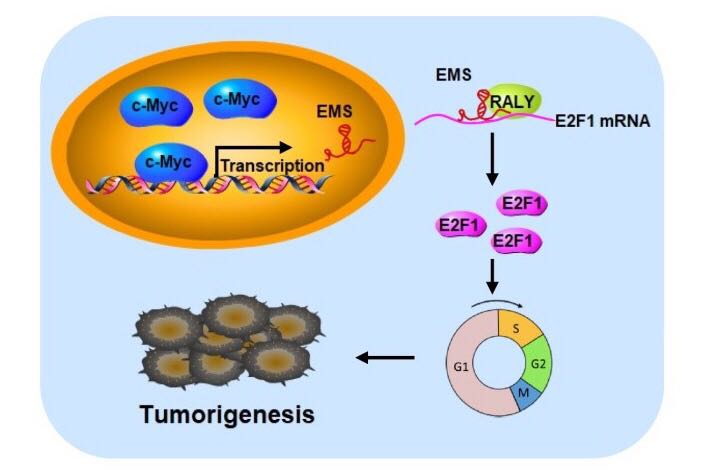USTC Finds the Importance of Long Noncoding RNA - EMS
As one of the most important oncogenes, c-Myc is activated in over half of human cancers, its oncogenic function has been largely attributed to its intrinsic nature as a master transcription factor. Dysregulation of long noncoding RNAs (lncRNAs) has been implicated in a variety of human diseases, including cancer. However, the function of lncRNA in the regulation of c-Myc oncogenic activity is still not well understood.
The research team led by Prof. MEI Yide, from the School of Life Sciences of University of Science and Technology of China, published a paper entitled Long noncoding RNA EMS connects c-Myc to cell cycle control and tumorigenesis in PNAS on July 1st. They reported the long noncoding RNA (lncRNA) E2F1 messenger RNA (mRNA) stabilizing factor (EMS) as a direct c-Myc transcriptional target.
According to Prof. MEI, given that the intracellular protein c-Myc is still indispensable in normal cells, simply inhibits its function is not practical, so the research direction switched to find the precursor or successor in its process of promoting cancer. Through database analysis and experimental verification, the team identified a new long noncoding RNA with abnormally high expression and cancer-promoting functions in various types of tumors including lung, breast and colon carcinomas. The team named it E2F1 mRNA stabilizing factor (EMS, the same abbreviation of Express Mail Service, as they both send messages). As a direct transcriptional target of c-Myc, EMS could mediate the role of c-Myc in promoting tumor formation by controlling cell cycle function. Mechanistically, EMS associates with the RNA binding protein RALY, thereby stabilizing the mRNA of the cell cycle key regulator E2F1 and enhancing its protein expression level, ultimately promoting the G1/S cell cycle and the rapid proliferation of tumor cells. This study clarified that EMS, a long noncoding RNA, can act as a messenger molecule to transmit c-Myc's cancer-promoting signal, providing a new perspective for understanding the molecular basis of c-Myc to promote tumor formation, and suggesting that EMS may be used as a new potential target in tumor treatment.

Fig1: The action mechanism of EMS. (Image by MEI Yide’s team)
The research reports that as a transcriptional target of c-Myc, lncRNA E2F1 messenger RNA (mRNA) stabilizing factor regulates c-Myc function via modulating E2F1 mRNA stability. Meanwhile, the study also provides insights into the mechanisms of how c-Myc promotes tumorigenesis. In conclusion, these findings reveal a previously unappreciated mechanism through which c-Myc induces E2F1 expression and also implicate EMS as an important player in the regulation of c-Myc function.
As molecules are multifunctional, more paths in cancer promoting probably also exists. The team planned to further research in EMS and try to find other cancer promoting mechanisms in their follow-up researches. “We hope our research can make sense to help human win in the war with cancer”, said Prof. MEI.
Paper Link:https://www.pnas.org/content/early/2019/06/25/1903432116.short?rss=1
(Written by LI Xiaoxi / JIANG Pengcen, edited by LI Xiaoxi, USTC news center)
Back
